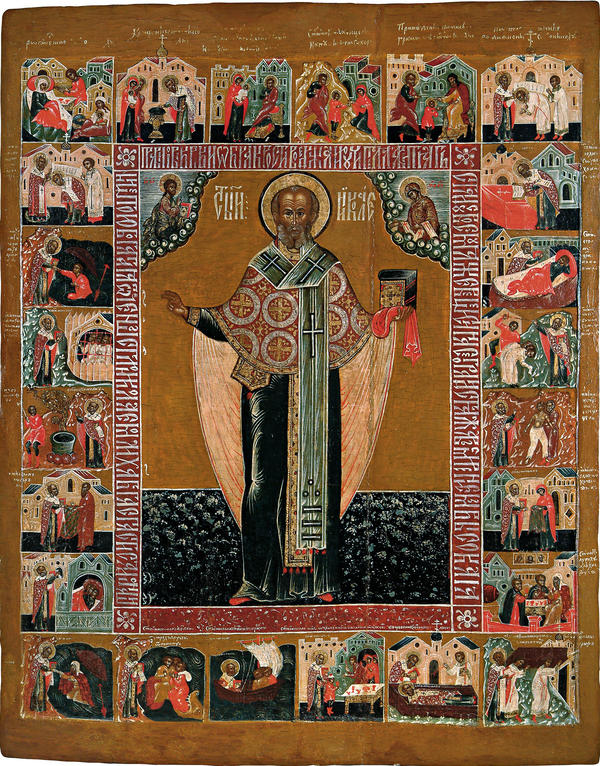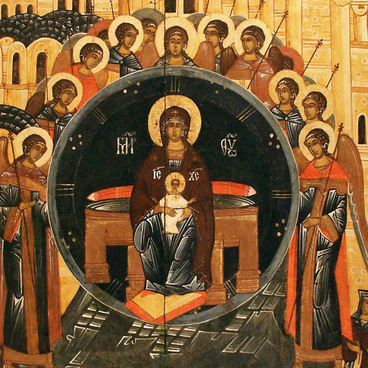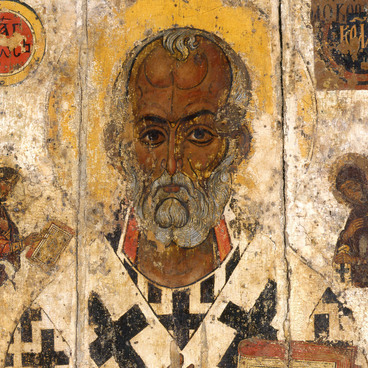The icon of Nicholas the Wonderworker was painted by an unknown artist in about 1677. Originally, it was held by the Murom Church of St. Nicholas in Zaryadye. The church was built in 1675-1677 and funded by a local merchant, Ivan Smolin. For decoration purposes, he ordered icons, one of which is displayed here.
In Orthodox Church, St. Nicholas the Wonderworker is among the most revered holy bishops. He lived in the late 3rd through the first half of the 4th century AD and was Archbishop of Myra in Lycia, Asia Minor (modern-day Turkey). He took part in the First Council of Nycaea, where he stood out as an ardent opponent of the heresy spoken by the presbyter Arius of Alexandria.
Compositionally, the icon consists of a centrepiece portraying the holy hierarch Nicholas himself, and hagiographical scenes along the border. The role of a prototype for the centrepiece was played by a canonical image known as St. Nicholas of Zaraisk. In Russian art, this image has been widespread since the 14th century. It ascends to a lost ancient icon of St. Nicholas, which was brought to the city of Zaraisk from Korsun (now, Kherson) in 1225.
In the centrepiece of the icon, St. Nicholas is portrayed with his hands apart, against a dark ochre background. His posture resembles the iconographic image of the Virgin Mary Orant. With his right hand, he blesses praying people, while he holds a closed Gospel on a red liturgical purificator in his left hand. In the corners of the centrepiece, there are the figures of Jesus Christ and the Holy Mother. They are located in segments resembling clouds. On a dark cherry frame around the centrepiece, the painter placed the text of a troparion to Nicholas, in ligatured letters: ‘The truth of thy deeds hath revealed thee to thy flock as a canon of faith, an icon of meekness, and a teacher of abstinence; for this cause thou hast achieved the heights by humility, riches by poverty, O Father and Hierarch Nicholas, intercede with Christ God that our souls may be saved’.
The border scenes are episodes of Nicholas’s life. Their composition is traditional with regard for such icons. The first few discuss the details of Holy Nicholas’s childhood. The wonderful events which took place in his green years predicted the saint’s great future.
The next two scenes remind of how Nicholas entered the ministry as a deacon and later a bishop. Most of the scenes are about the miracles performed by the saint during his lifetime and after death.
In Orthodox Church, St. Nicholas the Wonderworker is among the most revered holy bishops. He lived in the late 3rd through the first half of the 4th century AD and was Archbishop of Myra in Lycia, Asia Minor (modern-day Turkey). He took part in the First Council of Nycaea, where he stood out as an ardent opponent of the heresy spoken by the presbyter Arius of Alexandria.
Compositionally, the icon consists of a centrepiece portraying the holy hierarch Nicholas himself, and hagiographical scenes along the border. The role of a prototype for the centrepiece was played by a canonical image known as St. Nicholas of Zaraisk. In Russian art, this image has been widespread since the 14th century. It ascends to a lost ancient icon of St. Nicholas, which was brought to the city of Zaraisk from Korsun (now, Kherson) in 1225.
In the centrepiece of the icon, St. Nicholas is portrayed with his hands apart, against a dark ochre background. His posture resembles the iconographic image of the Virgin Mary Orant. With his right hand, he blesses praying people, while he holds a closed Gospel on a red liturgical purificator in his left hand. In the corners of the centrepiece, there are the figures of Jesus Christ and the Holy Mother. They are located in segments resembling clouds. On a dark cherry frame around the centrepiece, the painter placed the text of a troparion to Nicholas, in ligatured letters: ‘The truth of thy deeds hath revealed thee to thy flock as a canon of faith, an icon of meekness, and a teacher of abstinence; for this cause thou hast achieved the heights by humility, riches by poverty, O Father and Hierarch Nicholas, intercede with Christ God that our souls may be saved’.
The border scenes are episodes of Nicholas’s life. Their composition is traditional with regard for such icons. The first few discuss the details of Holy Nicholas’s childhood. The wonderful events which took place in his green years predicted the saint’s great future.
The next two scenes remind of how Nicholas entered the ministry as a deacon and later a bishop. Most of the scenes are about the miracles performed by the saint during his lifetime and after death.



